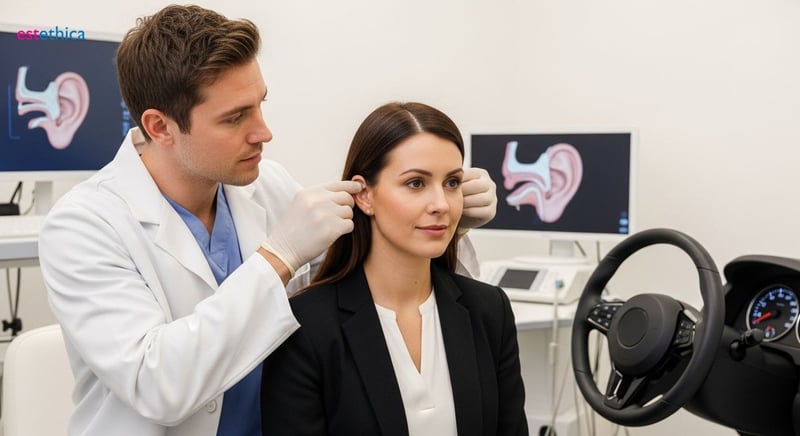Unveiling Otoplasty: Your Guide to Ear Reshaping Surgery
Unveil the artistry of cosmetic ear surgery and embark on a journey to achieve balanced aesthetics with otoplasty.
Otoplasty, more commonly known as cosmetic ear surgery, is a transformative procedure aimed at enhancing the appearance and function of the ears. Whether you are seeking to correct protruding ears or improve symmetry, cosmetic ear surgery offers solutions that combine art and science. Delve into the world of ear aesthetics and discover how this procedure can harmonize your facial features.
What is Otoplasty? Understanding Ear Reshaping
Understanding the Basics of Otoplasty Surgery
Otoplasty, commonly known as ear surgery or ear reshaping, is a surgical procedure designed to correct the shape, position, or size of the ears. Often, individuals seek this procedure to address protruding ears, a condition where the ears stick out noticeably from the side of the head. This can be a source of self-consciousness, particularly among children and teenagers. The goal of Otoplasty is to create a more natural and balanced appearance, enhancing overall facial aesthetics. According to recent studies, approximately 85% of patients who undergo Otoplasty report a significant improvement in their self-esteem and body image.
Cosmetic Ear Surgery is not just about aesthetics; it can also correct structural defects caused by injury or congenital disabilities. The procedure involves reshaping the cartilage of the ear to achieve the desired outcome. This might include reducing the size of large ears, pinning back protruding ears, or correcting deformities caused by trauma. For instance, a patient who has experienced an ear injury might opt for Otoplasty to restore the ear's natural shape. Similarly, individuals with congenital ear deformities, such as Stahl's ear or lop ear, can benefit from surgical correction.
Otoplasty can be performed on individuals of all ages, although it is often recommended that children be at least five years old, as their ear cartilage is typically stable enough for surgical correction by this age. The psychological benefits of undergoing Otoplasty can be profound, especially for younger patients who may be subjected to teasing or bullying due to their ear shape. Otoplasty not only improves physical appearance but also fosters greater confidence and self-acceptance. Pinnaplasty is another term used to describe Otoplasty.
Ideal Candidates for Ear Pinning and Reshaping
- Children with Stable Ear Cartilage: Otoplasty is often performed on children once their ear cartilage has reached sufficient stability, typically around the age of five or six. This ensures that the surgical correction is long-lasting and effective.
- Adults Seeking Aesthetic Improvement: Many adults seek Otoplasty to correct ear deformities or reduce the prominence of their ears. This procedure can significantly enhance facial harmony and boost self-confidence.
- Individuals with Congenital Ear Deformities: Otoplasty can address a variety of congenital ear deformities, such as Stahl's ear, lop ear, or constricted ear, helping to create a more natural and balanced appearance.
Ear surgery aims to improve the proportion and shape of the ear. Ear Pinning is a related term, often used when the primary goal is to set prominent ears back closer to the head. The procedure is tailored to meet the unique needs and aesthetic goals of each patient, ensuring personalized and satisfactory results. Otoplasty is a versatile procedure that can address a wide range of ear-related concerns, enhancing both appearance and self-esteem.
The Otoplasty Procedure: A Step-by-Step Overview
- Initial Consultation and Assessment: The first step involves a thorough consultation with a qualified surgeon. During this meeting, the surgeon will assess the patient's ear structure, discuss their aesthetic goals, and determine the most appropriate surgical approach.
- Surgical Correction: The Otoplasty procedure typically involves making an incision behind the ear to access the cartilage. The surgeon then reshapes or removes cartilage as needed to achieve the desired contour and position.
- Closure and Recovery: Once the reshaping is complete, the incisions are closed with sutures. A bandage is applied to support the ears during the initial healing phase. Patients can typically return to their normal activities within a week or two, following the surgeon's post-operative instructions.
The benefits of Otoplasty extend beyond physical appearance. Many patients experience a significant boost in self-confidence and social comfort. Ear surgery can be a transformative experience, helping individuals feel more at ease with their appearance and improving their overall quality of life. Otoplasty surgery is a safe and effective procedure when performed by a skilled and experienced surgeon.

Ear Pinning: Correcting Protruding Ears for a Balanced Look
The Role of Ear Pinning in Otoplasty
Ear pinning, a specific type of Otoplasty, primarily focuses on correcting protruding ears. This condition, where one or both ears stick out noticeably from the side of the head, is a common reason individuals seek ear surgery. The procedure involves reshaping the ear cartilage to position the ears closer to the head, thereby improving facial symmetry and overall appearance. For example, some patients may have ears that protrude at a sharp angle, while others may have more subtle but still noticeable prominence. Effective correction can lead to a significant boost in self-esteem.
The goal of ear pinning is not just to flatten the ears against the head, but to create a natural and aesthetically pleasing contour. Surgeons carefully assess the patient's ear structure and facial features to determine the optimal degree of correction. This involves techniques such as scoring or reshaping the cartilage to achieve a softer, more natural curve. For instance, some surgeons use sutures to hold the cartilage in its new position, while others may remove a small amount of cartilage to reduce protrusion. The approach is customized to the individual's unique anatomy and desired outcome. The success of ear pinning relies heavily on the surgeon's skill and understanding of facial aesthetics. Cosmetic Ear Surgery is one of the solutions that can be used for this.
Benefits of Correcting Protruding Ears
- Improved Facial Harmony: By bringing the ears closer to the head, ear pinning enhances facial symmetry and creates a more balanced appearance. This can significantly improve overall aesthetics and boost self-confidence.
- Increased Self-Esteem: Many individuals with protruding ears feel self-conscious about their appearance. Corrective surgery can alleviate these concerns, leading to greater self-assurance and social comfort.
- Enhanced Quality of Life: Feeling good about one's appearance can have a positive impact on various aspects of life, from social interactions to professional opportunities. Ear pinning can contribute to an improved sense of well-being and overall quality of life.
Techniques Used in Ear Pinning Surgery
- Cartilage Reshaping: This involves modifying the shape of the ear cartilage to reduce protrusion. Surgeons may use sutures to create a new fold in the cartilage or remove a small amount of cartilage to achieve the desired contour.
- Suture Placement: Sutures are strategically placed to hold the cartilage in its new position. These sutures are typically permanent and help maintain the corrected shape over time.
- Incision and Closure: Incisions are usually made behind the ear to minimize visible scarring. The incisions are then closed with sutures, and a bandage is applied to support the ears during the initial healing phase.

Pinnaplasty and Beyond: Exploring Surgical Techniques
Understanding Pinnaplasty Techniques for Ear Reshaping
Pinnaplasty, a refined subset of Otoplasty, meticulously addresses prominent ears through targeted reshaping. This technique often involves strategic incisions and sutures to redefine the cartilage structure, effectively reducing the ears' projection. The artistry of pinnaplasty lies in achieving a natural-looking result that harmonizes with the patient's facial features. For instance, a surgeon might employ a scoring technique to weaken the cartilage, allowing it to bend more easily into the desired position. Another approach involves the removal of a small wedge of cartilage to reduce overall ear size. The choice of technique depends on the patient's unique anatomy and aesthetic goals. Pinnaplasty is tailored to meet the specific needs of each individual.
While surgical intervention remains the gold standard for significant ear reshaping, non-surgical methods continue to evolve. These non-invasive approaches typically offer temporary solutions, making them suitable for individuals who are hesitant about surgery or seeking to test the waters before committing to a permanent change. For example, ear molding, a technique commonly used in infants, involves the application of custom-fitted molds to reshape the ear cartilage. Although primarily used in newborns, similar methods are being explored for older children and adults. The exploration of non-surgical alternatives reflects a growing demand for less invasive cosmetic procedures. Pinnaplasty is a versatile procedure that can be adapted to suit a variety of patient needs and preferences.
The Impact of Successful Pinnaplasty
- Enhanced Self-Esteem: Successful pinnaplasty can significantly boost self-esteem, particularly for individuals who have been self-conscious about their prominent ears. This newfound confidence can positively impact various aspects of their lives, from social interactions to professional opportunities.
- Improved Social Comfort: By reducing the prominence of the ears, pinnaplasty can alleviate feelings of self-consciousness and improve social comfort. Patients may feel more at ease in social situations and less concerned about their appearance.
- Greater Psychological Well-Being: Undergoing pinnaplasty can lead to a greater sense of psychological well-being. Feeling good about one's appearance can have a profound impact on overall mental health and happiness.
Advancements in Non-Surgical Ear Reshaping
- Ear Molding Techniques: Ear molding, commonly used in infants, involves the application of custom-fitted molds to reshape the ear cartilage. This non-invasive approach can effectively correct ear deformities in newborns and is being explored for older individuals as well.
- Suture Suspension Methods: Some non-surgical techniques involve the use of sutures to gently lift and reposition the ear cartilage. These sutures are placed strategically to create a more balanced and aesthetically pleasing appearance.
- Injectable Fillers: While less common, injectable fillers can be used to add volume to certain areas of the ear, improving its overall shape and contour. This approach is typically used for minor corrections and enhancements.

Otoplasty Recovery: Tips for a Smooth Healing Journey
Essential Steps for a Swift Otoplasty Recovery
Recovery following Otoplasty is a crucial phase that significantly impacts the overall success of the procedure. Typically, this period involves a brief span of rest, succeeded by a gradual return to everyday activities. Adhering to your surgeon's instructions is paramount, as it ensures optimal healing and minimizes potential complications. For instance, you may be advised to wear a specific type of bandage or headband to protect your ears and maintain their new shape. It's also important to keep the head elevated, especially during the initial days post-surgery, to reduce swelling. Avoiding strenuous activities that could strain the ears is also essential. Otoplasty recovery is a process that demands patience and diligence.
The initial days after Otoplasty are critical for minimizing swelling and discomfort. Patients are typically advised to rest and avoid any activities that could potentially impact the ears. This might include refraining from contact sports or heavy lifting for several weeks. Pain management is usually achieved with over-the-counter or prescription pain relievers, as directed by your surgeon. Regular follow-up appointments are essential to monitor the healing process and address any concerns. For example, your surgeon will check for signs of infection and ensure that the incisions are healing properly. Proper care and attention during this phase can lead to a smoother and more comfortable recovery. Cosmetic Ear Surgery can provide solutions for a variety of ear-related concerns.
Key Strategies for a Seamless Otoplasty Recovery
- Adhere to Post-Operative Instructions: Following your surgeon's guidelines is crucial for optimal healing. This includes wearing bandages or headbands as directed, taking prescribed medications, and attending follow-up appointments.
- Maintain Head Elevation: Keeping your head elevated, especially during the initial days after surgery, helps reduce swelling and discomfort. Use extra pillows when resting or sleeping to maintain an elevated position.
- Avoid Strenuous Activities: Refrain from activities that could strain the ears, such as contact sports or heavy lifting, for several weeks after surgery. This helps prevent complications and ensures proper healing.
Maximizing Comfort During Your Otoplasty Recovery
- Proper Wound Care: Keeping the incision sites clean and dry is essential to prevent infection. Follow your surgeon's instructions for wound care, which may include gentle cleaning with mild soap and water.
- Pain Management: Managing pain effectively can significantly improve your comfort during recovery. Take pain relievers as prescribed by your surgeon and apply cold compresses to reduce swelling.
- Rest and Relaxation: Getting adequate rest is crucial for the healing process. Create a relaxing environment and avoid activities that could cause stress or anxiety.
Strategic Cartilage Reshaping and Suturing Techniques for Natural-Looking Otoplasty Results
estethica employs strategic cartilage reshaping during Otoplasty, utilizing precise incisions and sutures to redefine the ear structure and reduce projection. This meticulous approach ensures natural-looking results that harmonize with the patient's facial features, avoiding a flattened or unnatural appearance.
estethica's surgeons possess extensive experience in pinnaplasty and ear pinning, tailoring techniques to meet each patient's unique anatomy and aesthetic goals. Their deep understanding of facial aesthetics ensures optimal correction and patient satisfaction, solidifying estethica's position as a leader in cosmetic ear surgery.
Personalized Otoplasty Recovery Plans for Swift and Comfortable Healing
estethica provides personalized otoplasty recovery plans, emphasizing adherence to post-operative instructions, proper wound care, and effective pain management. The hospital's commitment to patient safety and comfort ensures a smooth healing journey, minimizing potential complications and promoting optimal results.
Patients at estethica report feeling more at ease with their appearance and experience an improved overall quality of life following Otoplasty. The hospital’s dedication to patient satisfaction is reflected in the positive outcomes and enhanced self-esteem experienced by those who undergo ear surgery at estethica.
Frequently Asked Questions
What is Otoplasty, and who is a good candidate for ear surgery?
What does ear pinning involve, and how does it improve appearance?
What are the different surgical techniques used in cosmetic ear surgery?
What can I expect during the recovery period after Otoplasty?
Are there non-surgical alternatives to Otoplasty for ear reshaping?
Ready to discover your healthiest, most beautiful self with estethica's personalized care?
📞 Book Your Free Consultation!